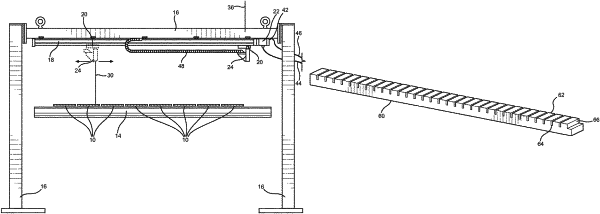| CPC G01B 11/046 (2013.01) [G06T 7/80 (2017.01)] | 2 Claims |

|
1. A method for measuring the width of a strip or the widths of multiple strips being conveyed longitudinally through a sensing region using a laser point displacement sensor that traverses a point laser and an optical sensor along a line that is aligned to direct a laser beam from the point laser along a passline laterally of the strip or strips, the method comprising:
(a) positioning in the sensing region a correction bar that has a series of alternating lands and grooves that are machined in the correction bar and form a series of spaced, land edges having precisely known actual distance positions of the land edges from a reference position;
(b) sensing, across a sensing region, the land edge distance positions from the reference position to generate a data set of sensed correction bar distance positions;
(c) calculating with a digital processor, for each sensed correction bar edge distance position, the algebraic sum of each sensed correction bar distance position with its nearest corresponding actual distance position to generate a set of corrections, each correction being associated with a sensed correction bar distance position;
(d) calculating, from the set of corrections and associated correction bar distances and using a regression analysis, a mathematical function that expresses a correction as a dependent variable as a function of a sensed distance position as its independent variable, continuously across the sensing region;
(e) positioning the strip or strips in the sensing region;
(f) sensing the distance positions of the strip edges positioned across the sensing region;
(g) inserting in the mathematical function as a dependent variable each sensed strip edge distance position to generate a set of actual strip edge positions;
(h) calculating the actual width of the strip or strips from the differences between adjacent actual strip edge distance positions.
|